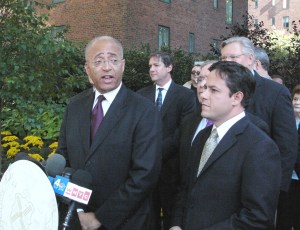Thompson, Electeds Rally Behind Stuy Town Tenants; Bloomberg Doesn’t
By Eliot Brown October 22, 2009 10:12 pm
reprints It didn’t take long for elected officials to declare victory Thursday. Press releases went out all morning, and then five hours after the Court of Appeals dropped its far-reaching court decision on Stuyvesant Town, a pack of local electeds assembled on the northeast corner of First Avenue and 16th Street to hold a press conference before a gathering of reporters, cameras and curious tenants. Councilman Dan Garodnick, mayoral hopeful Bill Thompson, State Senator Tom Duane, Assemblyman Brian Kavanagh, and Borough President Scott Stringer were all on hand, eager to step before the microphones and cheer.
It didn’t take long for elected officials to declare victory Thursday. Press releases went out all morning, and then five hours after the Court of Appeals dropped its far-reaching court decision on Stuyvesant Town, a pack of local electeds assembled on the northeast corner of First Avenue and 16th Street to hold a press conference before a gathering of reporters, cameras and curious tenants. Councilman Dan Garodnick, mayoral hopeful Bill Thompson, State Senator Tom Duane, Assemblyman Brian Kavanagh, and Borough President Scott Stringer were all on hand, eager to step before the microphones and cheer.
The purpose? To declare victory against the money-loving, rent-raising, tenant-hating behemoth (their implied description) landlord that is Tishman Speyer, and to show the 20,000 or so tenants/constituents/voters who live in the complex that they support the decision. The ruling, which still must be interpreted by a lower court to determine its full implications, will halt the deregulation of vacant rent-stabilized apartments, and end the pressure Tishman Speyer has felt to step up evictions of regulated tenants (thereby gaining market rate rents from the next tenants).
“After what they have done to tenants for the past several years–legal notices, aggressive actions, now inspections of every unit on the property with very, very little notice or warning,” Garodnick said, “it’s hard to feel very bad for them.”
Thompson, who has said he wants more rent protections for existing tenants, didn’t go as far in lashing out at Tishman Speyer, but celebrated the tenants.
“This is a great day, a great victory,” he said.
He went on to recall the failed effort of the tenants to buy the complex in 2006, and called the day when Tishman was officially named the winning bidder, “a dark day for affordability in New York.”
But it’s almost curious he didn’t make a bigger deal of this, as it’s a populist, pro-tenant issue where he actually does have a rather different approach than Mayor Bloomberg. Thompson supported the tenants’ efforts to buy the complex themselves–for which they were hoping for city subsidies to help keep the property affordable–whereas Bloomberg preferred to let the private market do its thing, going to the highest bidder. The guiding theory behind going with a high bid–aside from a general predilection toward an unrestrained marketplace–was that the market rate complex would bring in tremendous amounts of tax revenue that could be better put to use to build or preserve housing on less valuable pieces of land. (The sale alone brought in more than $240 million to the city and state in transfer and mortgage taxes.)
Mid-afternoon, Bloomberg issued a statement that did not take a strong position either way–he said it “provides some degree of clarity on an issue that has been debated for a long time”–consistent with the approach his administration took during the litigation process.
Here’s the full statement:
“Today’s decision provides some degree of clarity on an issue that has been debated for a long time, although the scope of its impact will take more time to know. Creating and preserving affordable housing in a city with a growing population has been one of our most important priorities. The tenant protections provided by the State’s rent regulation laws have long been an essential measure to ensuring New York City accommodates people with a broad range of incomes, and today’s decision means fewer units will fall out of the system than otherwise would have. But we know that – despite the ruling – the regulations still don’t provide affordable housing to enough New Yorkers. That’s why we created and are implementing the nation’s largest municipal housing plan to create and preserve 165,000 affordable units – units with protections that go beyond rent regulation laws and maintain affordability based on New Yorkers’ incomes.”


